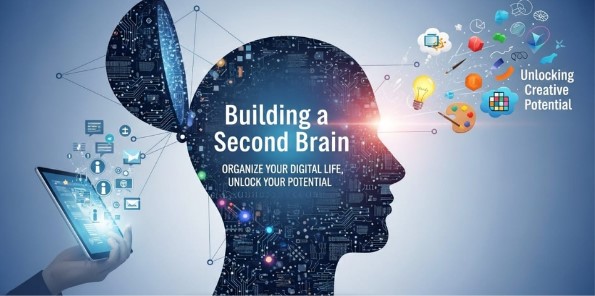In the information age, our biggest challenge isn’t finding knowledge — it’s managing it. Between emails, documents, audio notes, and countless browser tabs, modern professionals drown in digital clutter. The concept of the “second brain” has emerged as a revolutionary solution — a personalized, AI-powered system that stores, organizes, and retrieves information with the same fluidity as human memory.
With platforms like Skywork.ai leading this evolution, knowledge management is entering a new phase where creativity, structure, and automation merge to create something extraordinary: a digital extension of your mind.
- Why You Need a Second Brain
Every day, we’re bombarded with ideas, facts, and insights. But without a reliable system to organize them, most fade away. The second brain concept helps transform raw information into actionable knowledge.
Think of it as a digital notebook that doesn’t just store — it thinks. When combined with artificial intelligence, your second brain doesn’t just remember what you put in; it connects dots you didn’t know were related. It surfaces ideas when you need them most, enabling smarter decisions and faster creativity.
Professionals, entrepreneurs, and students alike are now using second brain systems to streamline their mental bandwidth — freeing their biological brain for high-level thinking while letting their digital one handle the data.
- How AI Reinvents Knowledge Management
Traditional note-taking tools store information, but they rarely help you use it effectively. AI changes that entirely.
An AI-driven second brain interprets meaning, detects themes, and relates new inputs to past data automatically. Instead of rigid folders, it builds semantic connections — dynamic links that evolve as your knowledge grows.
Imagine uploading a document about marketing trends. Your AI instantly links it to related ideas from months ago, summarizes key insights, and even suggests content connections you hadn’t noticed. This is the leap from static notes to living intelligence.
For instance, users can see related content within AI-powered platforms that contextualize information and enable continuous learning across projects. The system becomes a partner, not just a tool.
- Core Stages of Building a Second Brain
A structured framework helps bring your second brain to life:
- Capture – Store ideas, notes, and inspirations as soon as they occur. Use AI assistants to transcribe meetings, summarize research, or record thoughts hands-free.
- Organize – Let AI auto-tag and cluster data based on topic, relevance, or emotional tone. Goodbye, endless folder chaos.
- Distill – Extract insights from large bodies of information. The system can summarize long articles or highlight actionable steps automatically.
- Retrieve – Access anything instantly through smart search or natural-language queries (“Show me my last meeting notes about product strategy”).
This four-step cycle transforms your knowledge flow from disorganized storage to actionable intelligence.
- From Data to Insight: The Power of AI-Driven Context
A human brain thrives on pattern recognition — and so does your AI-enhanced second brain. By analyzing relationships between data points, AI identifies emerging patterns, predicts what might be relevant next, and even helps you rediscover forgotten knowledge.
For example, if you’re developing a proposal, your second brain can instantly pull related notes, statistics, and past drafts. It’s like having a silent co-pilot who remembers everything and knows exactly when to remind you of it.
This shift turns raw data into context-rich insight, allowing you to move from reactive work to proactive creation.
- Benefits Across Industries and Roles
The second brain concept isn’t limited to tech or academia — it applies to nearly every profession.
- Entrepreneurs: Keep track of business ideas, investor pitches, and product feedback — all searchable and connected.
- Students and Researchers: Organize reading materials, citations, and concepts into one AI-curated system.
- Content Creators: Turn brainstorms and references into organized creative blueprints.
- Corporate Teams: Maintain shared knowledge bases, where AI ensures continuity even as team members change.
This adaptability makes the second brain a universal productivity framework — scalable from solo freelancers to global enterprises.
- Designing a Sustainable Knowledge Ecosystem
Your second brain should feel organic — it evolves as you do. To build one that lasts, focus on these principles:
- Start small — capture what truly matters.
- Automate organization — use AI to categorize, not manual effort.
- Prioritize discoverability — ensure finding insights is faster than recalling them manually.
- Link generously — connections between ideas fuel creativity.
- Review regularly — a few minutes weekly keeps your system fresh and reliable.
When you align your digital habits with these rules, your second brain becomes a trustworthy partner in your creative and professional life.
- The Human Side of Digital Memory
It’s easy to think of the second brain as purely technical — but its ultimate goal is deeply human. By reducing mental clutter, it amplifies what matters most: focus, creativity, and clarity.
The paradox is that the more knowledge we externalize, the freer our minds become. The second brain doesn’t replace thinking; it frees you to think better. Instead of memorizing details, you spend your time making connections, innovating, and building meaning.
AI tools, when thoughtfully integrated, enable balance — turning technology into an extension of intuition rather than a distraction from it.
Conclusion
The age of intelligent knowledge management has begun. Building your second brain isn’t just about efficiency — it’s about empowerment. By uniting human creativity with artificial intelligence, we’re creating digital ecosystems that mirror the way we think, learn, and grow.
Platforms like Skywork.ai represent this evolution, showing how AI can transform information overload into structured, accessible wisdom. Through intelligent capture, contextual organization, and seamless retrieval, the second brain becomes more than a productivity system — it becomes your cognitive partner.
In the coming years, those who master the art of AI-driven knowledge management won’t just remember more — they’ll create more, think faster, and build better futures powered by both minds: the biological and the digital.

